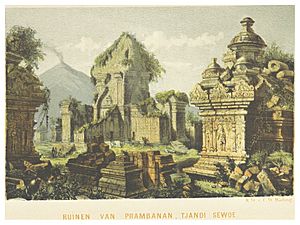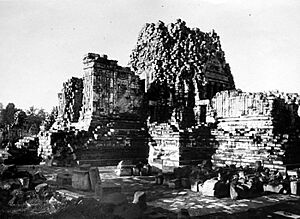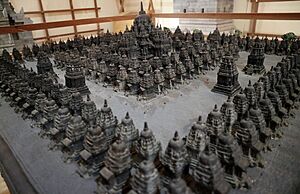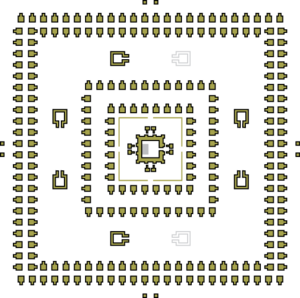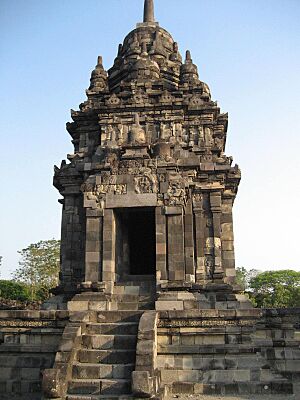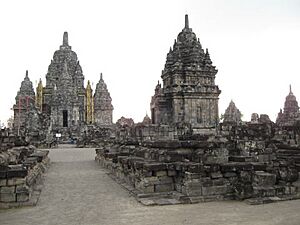Sewu facts for kids
Quick facts for kids Sewu Temple Compound (Manjusrigrha) |
|
|---|---|

The Sewu temple compound
|
|
| General information | |
| Architectural style | Buddhist candi |
| Town or city | Klaten Regency, Central Java |
| Country | Indonesia |
| Coordinates | 7°44′37″S 110°29′37″E / 7.7435°S 110.4935°E |
| Completed | circa 8th century |
| Client | Sailendra or Mataram Kingdom |
Sewu (which means 'a thousand' in Javanese) is an ancient Buddhist temple in Central Java, Indonesia. It was built in the 8th century. This temple is located about 800 meters north of the famous Prambanan temple.
In Indonesia, a temple like this is called a "candi." So, people often call it "Candi Sewu." Even though its name means 'a thousand temples,' the complex actually has 249 temples. This name comes from a local story called The Legend of Loro Jonggrang.
Archaeologists believe the temple's original name was Manjusrigrha. Sewu is the second largest Buddhist temple complex in Indonesia. Only Borobudur is bigger.
Contents
Exploring Sewu Temple's Past
How Sewu Temple Was Built
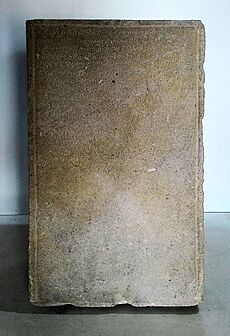
Old stone writings, called inscriptions, tell us about Sewu Temple. The Kelurak inscription (from 782 CE) and the Manjusrigrha inscription (from 792 CE) suggest the temple's first name was "Manjusri grha". This means 'The House of Manjusri'.
Manjusri is a special figure in Mahayana Buddhism. He represents wisdom. Sewu Temple was likely finished around the end of the 8th century. It was built during the time of King Rakai Panangkaran and completed by his successor, King Indra. Rakai Panangkaran was a devoted Buddhist king of the Medang Mataram Kingdom.
The Manjusrigrha temple was the biggest Buddhist temple in the Prambanan Plain area. It was built before the nearby Hindu Prambanan temple and even before Borobudur. Sewu was the main royal Buddhist temple for the kingdom. Important religious events often took place here.
The Manjusrigrha inscription from 792 CE describes the temple's beautiful towers. Other smaller temples, like Bubrah and Gana, were probably guardian temples for Sewu. They protected the main complex from different directions. Before Borobudur and Prambanan were built, Sewu was likely the most important temple in the kingdom. The way the temples are set up, in a mandala pattern, shows how Buddhists saw the universe.
Sewu Temple might have been made even bigger during the rule of Rakai Pikatan. He was a prince who married a Buddhist princess named Pramodhawardhani. The fact that Sewu (Buddhist) and Prambanan (Hindu) temples are so close together suggests that people of both religions lived peacefully side-by-side. The large size of Sewu shows it was a very important religious place.
The temple is located on the Prambanan Plain. This area has many old sites, meaning it was a key center for religion, politics, and city life long ago.
Finding the Temple Again
Even though the temple was covered by volcanic ash from Mount Merapi, local Javanese never completely forgot it. But they didn't know its true history. Over many years, stories and legends about giants and cursed princesses were told.
People believed Prambanan and Sewu were built by magic, by many demons working for Bandung Bondowoso, as told in the legend of Loro Jonggrang. These stories probably helped keep the temples safe before the Java War (1825–1830). Villagers were too scared to move any stones, thinking the ruins were haunted.
In 1733, a Dutch merchant named Cornelius Antonie Lons wrote the first known description of Sewu and Prambanan temples. Later, in 1806–07, a Dutch archaeologist named Hermann Cornelius dug up the Sewu temples. He made the first drawings of the main temple.
After the British briefly ruled the Dutch East Indies, Thomas Stamford Raffles included Cornelius's drawing of Candi Sewu in his 1817 book, The History of Java.
During the Java War (1825–1830), some temple stones were taken to build forts. After the war, the temples suffered from looting. Many Buddha statues lost their heads, which were stolen. Some Dutch colonists took sculptures for their gardens. Local villagers even used foundation stones for building materials. Sadly, some of the best carvings and Buddha heads ended up in museums and private collections far away.
In 1867, Isidore van Kinsbergen took photos of Sewu after an earthquake caused the main temple's dome to fall. By 1978, all the Buddha heads were gone, stolen from the site.
In the early 1900s, efforts began to clear and rebuild the main temple. Over the years, many archaeologists studied Sewu. In 1960, an inscription found at the temple showed it was built in 792 CE, meaning it was from the late 8th century.
Recent Events at Sewu Temple
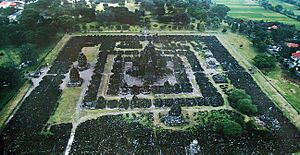
Since the early 20th century, the temple has been slowly and carefully rebuilt. However, it is not yet fully restored, as many stones are still missing. The main temple and two smaller temples on the east side were finished in 1993.
The temple was badly damaged during the 2006 Yogyakarta earthquake. The central temple was hit the hardest. Large pieces of stone fell, and cracks appeared. Metal frames were put up to support the main temple and stop it from collapsing. Even though the site reopened a few weeks later, the main temple stayed closed for safety. Today, the metal frames are gone, and visitors can enter the main temple again.
Sewu Temple often hosts the yearly Waisak Day ceremony, which is an important Buddhist holiday.
What the Temple Complex Looks Like
The Sewu temple complex is the biggest Buddhist area in Prambanan. It's a large rectangle, about 185 meters long and 165 meters wide. There are entrances on all four sides, but the main one is on the east. Each entrance is guarded by two large Dvarapala statues. These guardian statues are well-preserved.
The complex has 249 buildings arranged in a Mandala pattern around the main central hall. This pattern shows the Buddhist idea of the universe. There are 240 smaller temples, called Perwara (guardian) temples. They are arranged in four rows, forming rectangles. The two outer rows have 168 smaller temples, and the two inner rows have 72 temples. These smaller temples all have similar designs but once held different statues. Many statues are now gone.
Along the main north-south and east-west lines, between the second and third rows of smaller temples, are the apit (flank) temples. There were two on each side, facing each other. The apit temples are the second largest after the main temple. Today, only the eastern pair and one northern one remain. These temples once had larger rooms, but much has been looted. Behind the fourth row of smaller temples is a stone courtyard where the main temple stands.
The nearby Gana temple to the east and Bubrah temple to the south are thought to be part of the larger Manjusrigrha complex. They are about 300 meters from the main Sewu temple. Ruins to the north and west also suggest that Sewu was originally surrounded by four additional temples, matching the mandala and guardians of the directions concept.
The Main Temple
The main temple is about 29 meters wide and 30 meters tall. Its base is shaped like a 20-sided polygon with a cross shape. On each of the four main directions (north, south, east, west), there are parts that stick out. Each of these has stairs, entrances, and rooms, topped with stupas. All parts of the temple are made from strong andesite stones.
The main temple has five rooms. There is one large central room called a garbhagriha, and four smaller rooms, one in each main direction. These four rooms are connected by outer walkways with railings, decorated with small stupas.
During rebuilding, it was found that the central room was originally open, with four open structures around it. Later, doorways were added to connect these parts, making it one main building with five rooms. You can still see holes where wooden doors were once attached.
The central room is bigger than the others, with a higher ceiling. All five rooms are now empty. However, a stone base carved with a lotus flower in the central room suggests that a large bronze Buddhist statue once stood there. It might have been a statue of Manjusri, possibly as tall as four meters. The statue is missing, likely taken for its metal long ago. Another idea is that the main statue was made of stone blocks covered with a special plaster.
See also
- Buddhism in Indonesia
- Candi of Indonesia
- Indonesian Esoteric Buddhism
- Manjusrigrha inscription (792)
- Bubrah


